Coming Soon
Cause (BRONZE)
Client Credits: Raising the Roof
Raising the Roof
Agency Credits: Leo Burnett
Agency: Leo Burnett, Toronto
Chief Creative Officer: Judy John
Creative Director: Lisa Greenberg
Group Creative Director: Anthony Chelvanathan, Steve Persico
Copywriter: Steve Persico
Art Director: Anthony Chelvanathan
Executive Producer: Franca Piacente
Group Account Director: Natasha Dagenais
Account Supervisor: Kayla Osmond
Chief Strategy Officer: Brent Nelsen
Production Company: Skin & Bones
Director: Angie Bird
Director of Photography: Anthony Deluca, Michael Chiang
Producer: Tony Phibbs, Jeff Schwartz
Location Manager: Christian Wood
Editing Company: Rooster Post-Production
Editor: Chris Parkins
Assistant Editor: Craig Jay
Producer: Yumi Suyama
Post-Production Company: Fort York
Producer: Erice Bourgalt-Assaf
Music House: The Eggplant
Producer: Rocco Gagliese
Engineer: Nathan Handy
Executive Producer: Nicola Treadgold
Production Coordinator: Lindsay Fry
Section I — CASE PARAMETERS
| Business Results Period (Consecutive Months): | October 8 to November 30, 2015 |
| Start of Advertising/Communication Effort: | October 7, 2015 |
| Base Period as a Benchmark: | October 8 to November 30, 2014 |
| Geographic Area: | Canada |
| Budget for this effort: | $0 – $50,000 |
Section IA — CASE OVERVIEW
Why should this case win in the category (ies) you have entered?
This is a story about a mouse that roared. How a tiny not-for-profit with no budget put the problem of homelessness directly into people’s backyard and evoked an immediate response. It clearly demonstrates how strategy drove creative, which drove results for Raising the Roof.
Section II — THE CLIENT’s BUSINESS ISSUES/OPPORTUNITIES
a) Describe the Client’s business, competition and relevant history:
Raising the Roof was established in 1996 with the mission of providing national leadership on long-term solutions to homelessness. They have a tremendous task on their hands – including, but not limited to:
- A huge degree of apathy towards the homeless – like when a 50-yr-old man froze to death in a bus shelter at Yonge/Dundas square[1].
- Just 2% of total charitable donations from individuals go towards housing and development[2].
- They compete with larger, better-known and better-funded organizations such as United Way, The Salvation Army, and Covenant House.
To demonstrate the difference in scale, Raising the Roof earned just under $1 million of revenue (the total of donations, grants, other programs) in 2014, while United Way earned over $522 million[3]. And, while Raising the Roof has just 6 full-time staff, Salvation Army has 8,011 employees[4].
b) Describe the Client’s Business Issues/Opportunities to be addressed by the campaign:
The hopelessness of homelessness
Every year, a staggering 235,000 Canadians experience homelessness and demand for social housing continues to increase year after year (figure 1).
Homelessness is a huge issue in Canada, with some estimates putting the cost to the Canadian economy at up to $7 billion a year. Canada’s most populous province, Ontario, was hit hardest when in 1995 the new premier Mike Harris abruptly cancelled the Provincial Housing Program [7], leading to Toronto City Council announcing homelessness to be a ‘national disaster'[7]. When has a ‘national disaster’ ever been solved by just 6 people? This was the context of our challenge.
FIVE-YEAR TOTAL WAITING LIST FOR SOCIAL HOUSING, CITY OF TORONTO, 2014
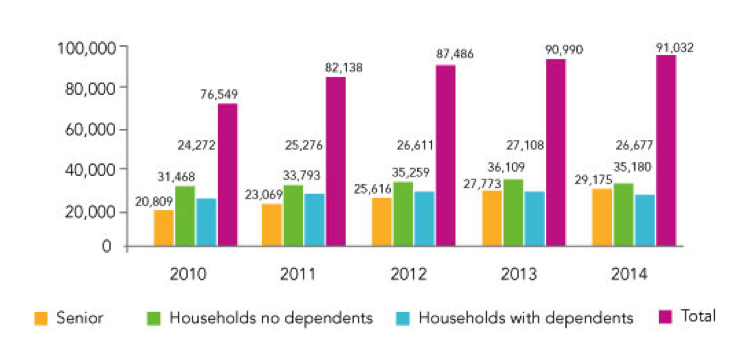
Figure 1: Housing Connections (2014). Annual Statistical Report 2014. Last accessed September 22, 2015 from: http://www.housingconnections.ca/pdf/annualReports/2014/2014%20Annual%20Report.pdf
c) Resulting Business Objectives: Include how these will be measured:
The message Raising the Roof wanted us to help them relay was essentially their mission statement, that short-term solutions are not the answer to the problem of homelessness. That instead there must be a focus on long-term solutions that put an end to homelessness for good. It’s not just shelters and pocket change on the street, it’s making policy changes at the government level.
Raising the Roof wanted to evoke an immediate and powerful response from a mass audience but they had a $0 media budget. In light of the above, we established the following three objectives*:
1.Put a new conversation about long-term solutions to end homelessness into the mainstream
2.Earn free impressions through coverage in mainstream news media
3.Drive donations for Raising the Roof
* Please note that given Raising the Roof’s size and limited resources, the objectives were not quantified.
[1] Source: http://www.cbc.ca/news/canada/toronto/man-dies-after-being-found-unconscious-in-bus-shelter-1.2890848
[2] Source: Statcan 2015. Spotlight on Canadians: Results from the General Social Survey. Charitable giving by individuals.
[3] Source: http://www.unitedway.ca/wp-content/uploads/2016/05/2015-UWCC-Annual-Report-EN.pdf VS.
http://www.raisingtheroof.org/wp-content/uploads/2015/10/2015_RTR_EN_AR-V5.pdf
[4] Source: http://www.salvationarmy.ca/annualreview2014-2015/
[5] Source: Sean Gadon, Director Affordable Housing Office, City Of Toronto March 9, 2016 Presentation To Ryerson University
[6] Source: http://lookoutsociety.ca/understanding-homelessness/cost-of-homelessness/the-real-cost-of-homelessness-in-canada
[7] Source: Sean Gadon, Director Affordable Housing Office, City Of Toronto March 9, 2016 Presentation To Ryerson University
Section III — YOUR STRATEGIC THINKING
a) What new learnings/insights did you uncover?
The heart of the solution came from understanding the heart of our audience.
The original target audience was “All Canadians”. Every Planner’s nightmare! We had no budget for any in-depth research, so we had to rely on Google, our friends and associates, the expertise of the Raising the Roof staff, our past research directly with the homeless from other Raising the Roof campaigns, and, quite honestly, our intuition.
To help narrow our focus, we looked at two very important aspects of this broad target audience’s behaviour and defined the desired shift we were looking for.
1. Their Relationship to Causes and Societal Issues
Behaviour: People’s rampant ADD.
In an era of 8s attention spans[8], people flip-flop from Facebook to YouTube, headline to headline, and one social cause to another. One minute it’s Ice Bucket Challenge videos, the next it’s updating our Facebook photo for gay rights. It’s easier than ever to be involved in everything while actually committing to nothing. It sounds like a destructive path for society, but we didn’t buy into the negativity. Any demonstration of support and understanding of the cause would be a good thing.
Action: Design a campaign that causes immediate interruption and evokes an immediate response.
2. Their Relationship to Homelessness
Behaviour: NIMBYism
We’re used to seeing the homeless on the side of the street every day. From time to time we throw some loose change into a cup but then we quickly move on – believing we’ve ‘done our part.’ People are tired of feeling compassion for homelessness and would prefer to pass the responsibility to somebody else[9]. And, that’s when we struck on the idea of the “NIMBY” – Not In My Back Yard – a person who wishes to keep issues at arm’s length.
Action: Make the shortcomings of short-term solutions to homelessness feel closer to home.
As we began to draft the creative brief, we realized we were still missing a key component – a single-minded and powerful insight to help guide us. As we went through all the learnings in a workshop setting, we repeatedly came back to the area of NIMBYism. Discussing different instances of NIMBYism we’d all encountered they all seemed to lead to immediate, emotional and significant responses. Exactly what we needed.
Insight: People’s concern for the homeless is surprisingly selfish.
It’s sad but true – when people give money to the homeless they feel they’ve absolved themselves from any further responsibility. They feel that it’s okay to leave the issue of homelessness right there on the street, at arm’s length, and then return to their comfortable lives and communities.
b) What was your Big Idea?
“Homeless Shelter – Coming Soon to Your Neighbourhood!”
Born out of NIMBYism, we staged a hoax that forced people to experience the shortcomings of short-term solutions to homelessness for themselves.
c) How did your Communication strategy evolve?
A Radically Different Approach
Cause-related marketing has a number of conventional communication approaches which were tempting to employ. We imagined the sad PSA and visually shocking print ad, which lectured people that their selfish behaviour is only exacerbating the problem of homelessness.
As we looked again at the daunting objectives and the two key dynamics within the broad target audience, we knew we had to take a radically different approach. We knew we would have to be brave to break through people’s apathy and lack of attention, make the problem of homelessness personally relevant, and insert the importance of long-term solutions into mainstream conversation.
So, we leaned-in to our insight to create a campaign that would evoke an immediate response.
d) How did you anticipate the communication would achieve the Business Objectives?
Everything from strategy to execution was carefully designed to evoke an immediate response from the media. Our approach:
1) Community – If we could shock the community we knew there would be potential for the story to spread outwards from the community to local media to a national conversation.
2) Controversy – It’s never fun to be the victim of a hoax but with such big objectives we had to create controversy to get picked up by the media.
3) Clarity – We organized a TV appearance by Carolann Barr, the executive director of Raising the Roof and developed a short video that would clarify our message and intent behind the hoax. In other words, we made sure to control the story as much as possible.
[8] Source: Microsoft attention spans, Spring 2015, Consumer insights, Author: Alyson Gausby
[9] Source: Leo Burnett Survey for Raising the Roof, 2011
Section IV — THE WORK
a) How, where and when did you execute it?
The hoax enabled us to reach the target in a way that broke cause-related marketing conventions. We literally forced our message and the issue into a community and watched as social feeds and the mainstream media responded immediately.
The key to the campaign was authenticity. No plot holes. We found a property for lease in an affluent area of Toronto and covered it with a plywood façade. The area, Leaside, is surrounded by some of the wealthiest neighbourhoods[10] in Toronto and is one of the last places anybody would expect to see a homeless shelter.
The plywood façade featured the sign:
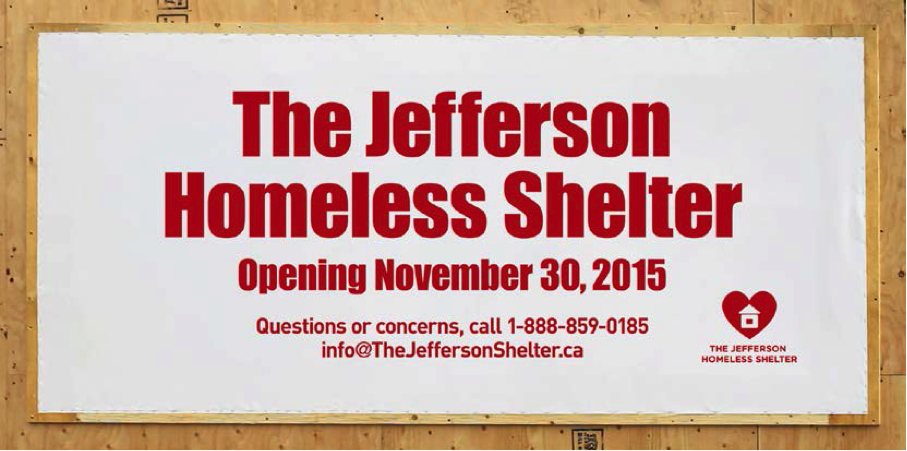
As this was clearly going to be a new neighbour within the community, it created an immediate uproar. People picked up the phone and did the talking for us. The message was clear – nobody wanted a shelter “in their backyard”.
The first sign was meant to be up for days but on account of the immediate and powerful response, we put up the second sign after just a few hours. Raising the Roof didn’t want a shelter in their backyard either.
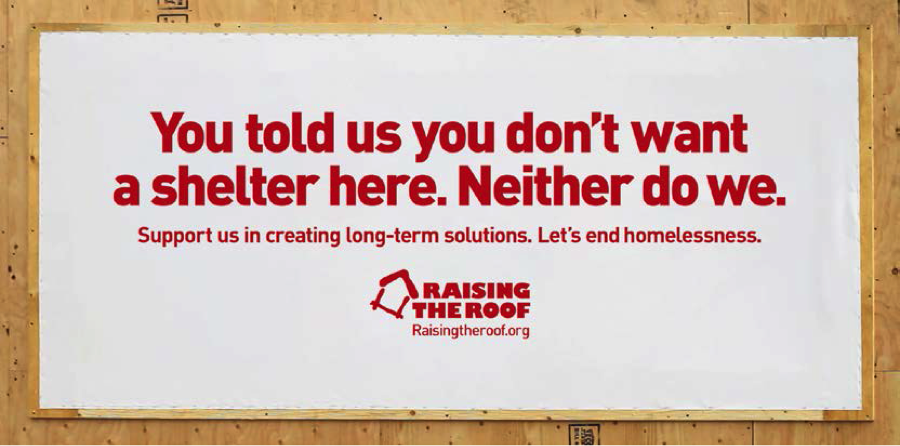
Showing the personal nature of the long-term problem through an online film helped make homelessness personal for the rest of Canada. It wasn’t a “prank” video – it was a way to get Canadians to feel something different about homelessness. It proved how passionate people could get about homeless solutions when the problem became personal.
c) Media Plan Summary
No paid media. Channels used were:
- Experiential – a donated location
- PR – free earned online media impressions and a TV appearance
- Social Media – Organic post to the Raising the Roof Facebook page and YouTube Channel
[10] Source: Canadian Business and Environics Analytics. http://www.canadianbusiness.com/lists-and-rankings/
richest-neighbourhoods/top-25-national-2015/image/24/
Section V — THE RESULTS
a) How did the work impact attitudes and behaviour?
Without a single dollar invested in traditional channels, we caused a media frenzy that reached every major Toronto news outlet and even other parts of the world.
The campaign effort generated coverage on HuffingtonPost.ca, Buzzfeed.com, Toronto Star, CP24, Independent.co.uk, and many more [how many more] – a total of nineteen articles resulting in an estimated 7,700,000 unique impressions[11] with zero dollars invested in media.
By the end of the frenzy, the video earned 52,000 views. A low number of views compared to viral global successes like Always #LAG or Canadian successes like West Jets Real Time Giving. However, by comparison to direct competitors dealing with similar issues, the featured video on United Way’s YouTube channel “2015 United Way National Campaign Video” launched a year ago had 76.5% fewer views[12]. Comparing the scale of United Way to Raising the Roof, we see this as a significant accomplishment for the organization.
Another example of the immediate and powerful response created was found in the organic reach, impressions, and engaged users once the video was posted to RTR’s Facebook page:
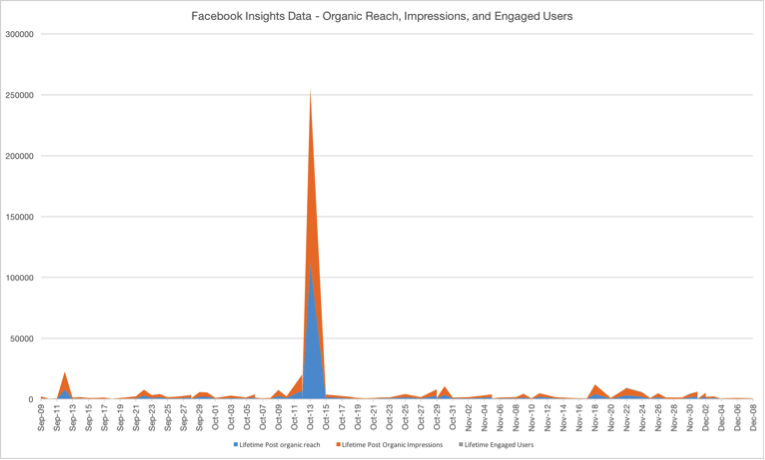
b) What Business Results did the work achieve for the client?
Most importantly, we put a conversation directly into the mainstream about long-term homelessness solutions and donations to Raising the Roof increased 506% vs. PY[13].
c) Other Pertinent Results
N/A
d) What was the campaign’s Return on Investment?
N/A – The campaign was pro-bono.
[11] Source: Media Agency
[12] Source: United Way Canada YouTube Channel
[13] Source: Client Organization – Raising the Roof
Section VI — Proof of Campaign Effectiveness
a) Illustrate the direct cause and effect between the campaign and the results
As you will see in the chart below, the launch of “Homeless Shelter – Coming Soon!” caused an immediate and powerful response in donations to Raising the Roof. Raising the Roof prefers not to release dollar figures by program, so advertising effect is demonstrated via percentage change vs. the same period from previous year. It is worth noting that November signals the launch of Raising the Roof’s inaugural “Toque Campaign” (so there is always an increase), but program mechanics from 2014 to 2015 were the same so the spike in donations from October seemed to carry momentum through to November[14].
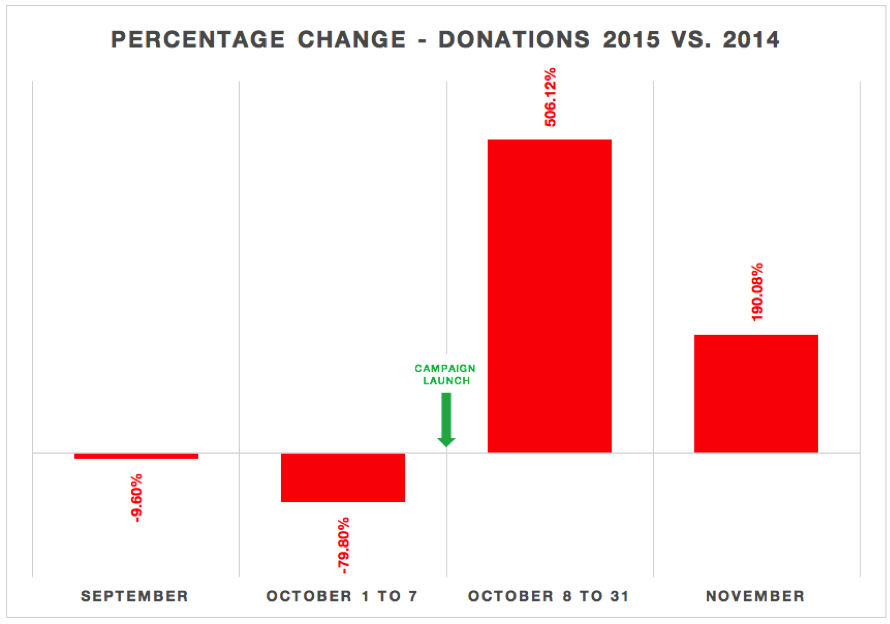
b) Prove the results were not driven by other factors
Campaign spend vs. history and competition:
The campaign execution was done Pro Bono and there was no investment in paid media channels.
Pre-existing Brand momentum:
The campaign had no pre-existing momentum as evidence downward trending donations versus the previous year.
Pricing:
Not applicable, as this was a fundraising campaign for a charitable organization.
Changes in Distribution/Availability:
Not applicable.
Unusual Promotional Activity:
The strategy and execution for this campaign is unusual by design, which is why it drew the response that it did.
Any other factors:
N/A
[14] Source: Client Organization – Raising the Roof